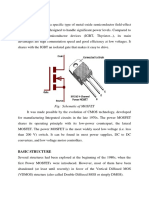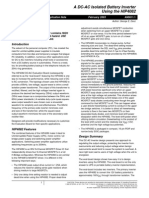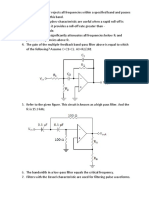Gate Driver Notes
Gate Driver Notes
Uploaded by
Beng FoongCopyright:
Available Formats
Gate Driver Notes
Gate Driver Notes
Uploaded by
Beng FoongOriginal Description:
Copyright
Available Formats
Share this document
Did you find this document useful?
Is this content inappropriate?
Copyright:
Available Formats
Gate Driver Notes
Gate Driver Notes
Uploaded by
Beng FoongCopyright:
Available Formats
P
side driver must be able to withstand the operating voltage of the high-side MOSFET. Typical maximum voltage ratings for high-voltage gate drivers can range from 80 to 100 V.
Frequently Asked Questions:
HIGH-VOLTAGE, TWO-PHASE GATE DRIVER ICs
What input voltage thresholds are available with high-voltage, two-phase gate driver ICs?
These gate driver ICs may accommodate CMOS or TTL input voltage thresholds.
What are the power dissipation considerations for the gate driver?
The total IC power dissipation includes the gate driver losses and Sam Davis, Contributing Editor the bootstrap diode losses. Gate driver losses What is a twodepend on the +HV Gate driver IC phase gate switching frequenVDD driver IC? cy, output load Bootstrap capacitance, and A two-phase gate diode VDD supply voltdriver IC is a power amplifier age. The power Highside driver that produces two losses associated high-current gate with driving the Bootstrap drives for either a output loads domicapacitor Level synchronous buck nate the power disshifter or half-bridge sipation at high freLoad totem-pole MOSquencies and high FET configuration load capacitance (see the figure). values. Bootstrap The two-phase diode power loss TTL/ Lowdriver provides the consists of the forCMOS IN side driver Lower buffer gate drive for both ward diode loss MOSFET a low-side and while charging the high-side n-chanbootstrap capacitor VSS nel MOSFET. In and reverse bias contrast, the sinpower loss during A two-phase gate driver has a floating high-side driver that provides the appropriate gle-phase gate reverse recovery. gate voltage and current while operating reliably with the voltage applied to the drain of driver services These events occur the upper MOSFET. only a single lowonce per cycle, so side MOSFET. this diode loss is also proportional to the switching What is the function of the level shifter? frequency. The level shifter must elevate the input voltage level to the appropriate range for the high-side driver (see the figure, again). For best results, the What are the design considerlevel shifter must operate at high speeds while consuming low power and ations for the capacitors providing clean level translations. employed with gate driver? A low equivalent series resistance/ How does the high-side driver support a high-voltage MOSFET? equivalent series inductance (ESR/ Gate voltage for the high-side driver employs a bootstrap supply circuit ESL) bypass capacitor must be comprising a bootstrap diode and bootstrap capacitor (see the figure, located near the IC between VDD again). The bootstrap diode may be either integrated within the gate driver and VSS. In addition, the bootstrap IC or external to it. Because the bootstrap capacitor value must be much capacitor requires a low ESR/ESL higher than the MOSFET gate capacitance, it is always external to the IC. type placed close to its connections When the lower MOSFET is enabled, the bootstrap capacitor charges up to the IC. These capacitors must to VDD via the bootstrap diode. Thus, the high-side gate driver floats at support high peak currents drawn the gate voltage of the high-side MOSFET. For reliable operation, the high- from VDD during turn-on of the
Sponsored by National Semiconductor Corp.
ADVERTISEMENT
external MOSFET. To prevent voltage transients at the drain of the upper MOSFET, connect a low ESR capacitor from its drain to VSS (ground).
What are the grounding considerations for the gate driver?
Grounding connections must confine the high peak currents from charging and discharging the MOSFET gates in as small an area as possible. This will decrease the loop inductance and minimize noise on the MOSFET gates. Plus, the MOSFETs must be located as close as possible to the gate driver.
100-V, Two-Phase Gate Drivers For Fast Switching MOSFETs
Can you keep both the highside and low-side MOSFETs from conducting simultaneously?
If both MOSFETs conduct at the same time, you get shoot-through current that causes electromagnetic interference (EMI), lowers efficiency, and reduces reliability. One approach to protecting against shoot-through is to control the dead time between the conduction intervals of the two MOSFETs. Insert a delay between the time that one driver turns off its associated MOSFET and the time the other driver turns on its associated MOSFET. By controlling the dead time, you optimize performance while getting the required dead time protection. Another approach to this potential problem is to include a non-overlap circuit that prevents the gate drivers from causing shoot-through of the two MOSFETs.
Four new 100-V power MOSFET gate drivers (listed in the table below) are now in National Semiconductors twophase gate-driver family. These ICs combine high peak current capability, fast rise and fall times, and closely matched propagation delays for their low-side and highside driver outputs. Among their potential applications are current-fed push-pull converters, half- and full-bridge power stages, synchronous buck converters, twoswitch forward converters, active clamp forward converters, and motor drives. The LM5100A and LM5101A are similar, except the LM5100A targets CMOS input voltage thresholds, and the LM5101A fits TTL. With a 1000-pF output load, these gate drivers exhibit 8-ns rise and fall times. Typical propagation delay matching of the two outputs is 3 ns, and the overall propagation delay is 25 ns (typical). With the addition of programmable dead time and enable input, along with a 100-V maximum rating, the LM5105 gate driver achieves added flexibility. A single external resistor programs the switching transition dead time through tightly matched turn-on delay circuits. With a 1000pF load, its rise and fall times are 15 ns. A lower-cost, two-phase gate driver with a 1.4-A peak current rating suits the LM5107 for motor drives and lower-power switching regulators. Propagation delay matching of this two-phase gate driver is only 2 ns. Rise and fall times are 15 ns for a 1000-pF load. Propagation times are 27 ns (typical).
Peak gate current 3.0 A 1.8 A 1.4 A Product ID Input threshold Packaging LLP-10, SO-8 LLP-10 LLP-8, SO-8 Comments Upgrade of HIP2100/01 Programmable dead time Upgrade of ISL6700
What causes gate circuit transients, and how can they be controlled?
The lower MOSFETs body diode clamps the node between the source of the upper MOSFET and the drain of the lower MOSFET. Board resistances and inductances sometimes cause this MOSFET drain-source node to generate undesirable transients. You can prevent these transients by inserting an external Schottky diode from low-side driver output to ground and/or from the high-side driver output and the drain-source node. ED Online 10130
LM5100A/01A CMOS/TTL TTL LM5105 TTL LM5107
For free online design tools, samples, evaluation boards, datasheets and more, BE SURE TO VISIT:
power.national.com
You might also like
- LEAP 1A Level 1 All ATA'sDocument38 pagesLEAP 1A Level 1 All ATA'sHENIGUEDRINo ratings yet
- FPGA Based LED Brightness Controller Using PWMDocument19 pagesFPGA Based LED Brightness Controller Using PWMIrfan DanishNo ratings yet
- HypersphereDocument2 pagesHypersphereMectronindiaNo ratings yet
- Why Mosfets FailDocument2 pagesWhy Mosfets FailkholshNo ratings yet
- Mosfet As AC SwitchDocument1 pageMosfet As AC Switchduppal35No ratings yet
- N Channel Mosfet TheoryDocument12 pagesN Channel Mosfet TheoryBrightchip Technologies100% (1)
- Buck-Boost Inverter Lab SheetDocument56 pagesBuck-Boost Inverter Lab SheetNebojsa VuksanNo ratings yet
- Testing A MOSFETDocument5 pagesTesting A MOSFETinter2176No ratings yet
- DC To Ac ConverterDocument13 pagesDC To Ac ConverterKawe ShopNo ratings yet
- Analog CircuitsDocument32 pagesAnalog CircuitstsangwanNo ratings yet
- A Simple TestDocument3 pagesA Simple Testkipkoech_rotichNo ratings yet
- The TRIAC - ThyristorsDocument3 pagesThe TRIAC - Thyristorsge_bdNo ratings yet
- GaN Research PaperDocument7 pagesGaN Research Papergurdiansky01No ratings yet
- Basic Triac-SCR Projects Circuits TutorialDocument7 pagesBasic Triac-SCR Projects Circuits TutorialAmmar YasserNo ratings yet
- TCAD Simulation Analysis of Tri-Gate Soi Finfet and Its ApplicationDocument11 pagesTCAD Simulation Analysis of Tri-Gate Soi Finfet and Its ApplicationShankul SainiNo ratings yet
- Transformer Based AC - DC ConverterDocument12 pagesTransformer Based AC - DC Converterayirp89No ratings yet
- Arduino Wireless Receiver - Transmitter Design - DocumentDocument11 pagesArduino Wireless Receiver - Transmitter Design - DocumentRaja Sekhar BatchuNo ratings yet
- Triacs and DiacsDocument4 pagesTriacs and Diacsssami670No ratings yet
- Photo TransistorsDocument15 pagesPhoto TransistorsAditi JaNo ratings yet
- CMOS Interview QADocument14 pagesCMOS Interview QAarammartNo ratings yet
- Chapter 4 - JFET PDFDocument13 pagesChapter 4 - JFET PDFnelsonjnelsonjNo ratings yet
- ESR Tester 096kDocument41 pagesESR Tester 096kFabrício Angiene100% (1)
- AN-31 Amplifier Circuit Collection PDFDocument42 pagesAN-31 Amplifier Circuit Collection PDFcasagrandeNo ratings yet
- Chapter 8: Field Effect Transistors: A. Introduction To FetsDocument10 pagesChapter 8: Field Effect Transistors: A. Introduction To FetsBmanNo ratings yet
- 1.5kva DC To Ac Power InverterDocument14 pages1.5kva DC To Ac Power InverterOnime Terryjane JeremiahNo ratings yet
- Radi0Kit 180 English Ver2.0Document11 pagesRadi0Kit 180 English Ver2.0MR XNo ratings yet
- A New CMOS Charge Pump For Low Voltage ApplicationsDocument4 pagesA New CMOS Charge Pump For Low Voltage Applicationskhausar1785No ratings yet
- Switch Mode Power Supply Basics TutorialDocument16 pagesSwitch Mode Power Supply Basics TutorialDavidNo ratings yet
- 4 Zener Voltage Regulator Diode Clippers ClampersDocument7 pages4 Zener Voltage Regulator Diode Clippers ClampersmakreloadedNo ratings yet
- Design For A Gate-Driver CircuitDocument27 pagesDesign For A Gate-Driver Circuitdhruv100% (1)
- Bilal Thesis (Repaired)Document104 pagesBilal Thesis (Repaired)khizarNo ratings yet
- A High Efficiency Mosfet Transformerless Inverter For Non-Isolated Micro-Inverter ApplicationsDocument4 pagesA High Efficiency Mosfet Transformerless Inverter For Non-Isolated Micro-Inverter ApplicationsPavan Kumar MangipudiNo ratings yet
- Mod ListDocument300 pagesMod ListTỏa Sáng100% (1)
- Design Automation For Differential MOS Current-Mode Logic CircuitsDocument235 pagesDesign Automation For Differential MOS Current-Mode Logic Circuitshenchiri.becherNo ratings yet
- Digital Electronics PDFDocument224 pagesDigital Electronics PDFMonika SharmaNo ratings yet
- The Design and Formula of DC To DC Converter SmpsDocument9 pagesThe Design and Formula of DC To DC Converter Smpsdewidewi76No ratings yet
- Filters QCMDocument15 pagesFilters QCMMary-Joe Semaani100% (1)
- MPPT Solar Charge ControllerDocument21 pagesMPPT Solar Charge ControlleranupamdubeyNo ratings yet
- Ieee TfetDocument3 pagesIeee TfetNirman KhairnarNo ratings yet
- Microcontrollers: Created By: Sachin Bhalavat (Elect. & Comm. Engg.)Document52 pagesMicrocontrollers: Created By: Sachin Bhalavat (Elect. & Comm. Engg.)madhu518No ratings yet
- DC-DC ConverterDocument12 pagesDC-DC ConvertersabariNo ratings yet
- Capacitor Power Supply Design NoteDocument8 pagesCapacitor Power Supply Design NoteIvez StrausseNo ratings yet
- Simple Multitasking With MicrocontrollersDocument4 pagesSimple Multitasking With MicrocontrollersEngr Muhammad Irfan ShahidNo ratings yet
- SPI I2C Bus Lines Control Multiple PeripheralsDocument10 pagesSPI I2C Bus Lines Control Multiple PeripheralsCarlos Roman Zarza100% (2)
- Basics of Analog-To-digital ConvertionDocument9 pagesBasics of Analog-To-digital ConvertionThanh Nhan LeNo ratings yet
- Circuit Theory and Design of Power Factor Correction Power SuppliesDocument51 pagesCircuit Theory and Design of Power Factor Correction Power Supplies양영주No ratings yet
- Common Mode Feedback and Differential AmplifiersDocument71 pagesCommon Mode Feedback and Differential Amplifiersreader_188No ratings yet
- Mixers 2Document20 pagesMixers 2Nelson Bernardo100% (1)
- SRD Pulse GeneratorDocument14 pagesSRD Pulse GeneratorraineymjNo ratings yet
- Seminar Presentation: Topic: Carbon Nano Tube Field Effect TransistorDocument12 pagesSeminar Presentation: Topic: Carbon Nano Tube Field Effect TransistormukulNo ratings yet
- LaunchPad Ecosystem Selection Guide Slat152bDocument17 pagesLaunchPad Ecosystem Selection Guide Slat152bventsym100% (1)
- Solid State Electronic Devices - D. K. Bhattacharya and R. Sharma PDFDocument94 pagesSolid State Electronic Devices - D. K. Bhattacharya and R. Sharma PDFSusmita GangulyNo ratings yet
- Esr LCR r2d2Document6 pagesEsr LCR r2d2Toñi Lopez Vilches100% (1)
- Digital Electronics Course MaterialDocument54 pagesDigital Electronics Course MaterialMuhammad SalisNo ratings yet
- Design of Igbt Based LLC Resonant InverterDocument7 pagesDesign of Igbt Based LLC Resonant InverterdhruvNo ratings yet
- DC Voltage TestingDocument44 pagesDC Voltage TestingAdriel BayNo ratings yet
- Universit' A Degli Studi Di Padova Ingegneria Elettronica: Tesi Di Laurea Specialistica inDocument119 pagesUniversit' A Degli Studi Di Padova Ingegneria Elettronica: Tesi Di Laurea Specialistica invijith133No ratings yet
- GSM - Architecture, Protocols and ServicesFrom EverandGSM - Architecture, Protocols and ServicesRating: 1 out of 5 stars1/5 (1)
- Yamaha Xvs 125 Maintenance ManualDocument86 pagesYamaha Xvs 125 Maintenance ManualPetrut Staicu100% (1)
- J990 Power Electronics Excitation Systems and Synchronous Machines FundamentalsDocument2 pagesJ990 Power Electronics Excitation Systems and Synchronous Machines FundamentalsHemant LimayeNo ratings yet
- MAGNA3 Data BookletDocument52 pagesMAGNA3 Data BookletAlexandru EnescuNo ratings yet
- Section 13H - Engine Malfunctions PDFDocument6 pagesSection 13H - Engine Malfunctions PDFrobbertmdNo ratings yet
- 1396767621physics Experiments 2013-14 Sec ADocument17 pages1396767621physics Experiments 2013-14 Sec AtishaprakashNo ratings yet
- 4CHLDocument1 page4CHLZNC Plamo and ToyzNo ratings yet
- 2014 F150 BrochureDocument28 pages2014 F150 BrochureTaylor Knight100% (1)
- Conectores Unipolares LevitonDocument60 pagesConectores Unipolares LevitonJuan Diego Arroyave SernaNo ratings yet
- 6b4-28197-5e-11 E15d PDFDocument168 pages6b4-28197-5e-11 E15d PDFAlexNo ratings yet
- Mercedes-Benz (Eu) Atego Atego 1823 ../L/LS/K (4X2) : Normal TropicalDocument4 pagesMercedes-Benz (Eu) Atego Atego 1823 ../L/LS/K (4X2) : Normal Tropicalعبدالغني القباطيNo ratings yet
- Manual: Powder CoatingDocument3 pagesManual: Powder CoatingHans LimNo ratings yet
- Mercury 2000 3000 3600-S0Document2 pagesMercury 2000 3000 3600-S0Asif KhanNo ratings yet
- Installation of Ac Ups: Project: Construction of Rail Fed Depot at Village Swaipura/Chotila, Dist-Pali, RajasthanDocument8 pagesInstallation of Ac Ups: Project: Construction of Rail Fed Depot at Village Swaipura/Chotila, Dist-Pali, RajasthansidharthNo ratings yet
- Widearea Eye/Face Washes G1721: Guardian EquipmentDocument2 pagesWidearea Eye/Face Washes G1721: Guardian Equipmenteisenbarger5607No ratings yet
- 993331G CAT Accessories Catalog LoRDocument32 pages993331G CAT Accessories Catalog LoRAgung Pramu AjiNo ratings yet
- LG5924 enDocument4 pagesLG5924 enTOPOTRONIKNo ratings yet
- DT Project Sem 4Document9 pagesDT Project Sem 4Utkarsh YadavNo ratings yet
- LM2576xx Series SIMPLE SWITCHER® 3-A Step-Down Voltage RegulatorDocument43 pagesLM2576xx Series SIMPLE SWITCHER® 3-A Step-Down Voltage RegulatordavidNo ratings yet
- SIemens Switch p-131200390241797489Document48 pagesSIemens Switch p-131200390241797489Gopalakrishnan RajuNo ratings yet
- Automatic Sand Filter MachineDocument10 pagesAutomatic Sand Filter MachineAryan AmeenNo ratings yet
- AC500 High AvailabilDocument48 pagesAC500 High Availabilg_325899365No ratings yet
- Programmable 3 Channel Power Supply 526Document2 pagesProgrammable 3 Channel Power Supply 526digiarkanandNo ratings yet
- Embedded SyllabusDocument5 pagesEmbedded SyllabusAbhishek Singh100% (2)
- Short Circuit FaultDocument9 pagesShort Circuit FaultnewattelectricNo ratings yet
- Ei PresentationDocument50 pagesEi PresentationSGVU UniversityNo ratings yet
- Smart ConsoleDocument50 pagesSmart ConsoleJohnny100% (1)
- MHT 10225 Repair Manual 2018 106 201Document96 pagesMHT 10225 Repair Manual 2018 106 201Ігор Веселов100% (2)
- VLSI System Design Lab Digital Assignment 1Document11 pagesVLSI System Design Lab Digital Assignment 1SMNo ratings yet

























































































